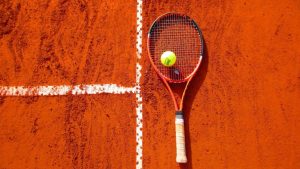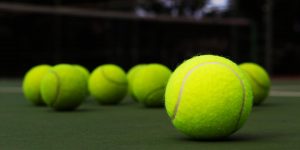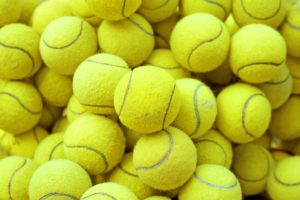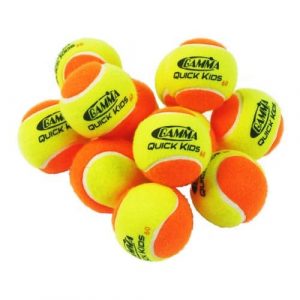 Players in all sports look to their equipment for peak performance during the game, and racket games are no exception. You may find yourself struggling to make sense of the over-saturation of features found on today’s equipment, including information designed to highlight what makes the best tennis balls out there.
Players in all sports look to their equipment for peak performance during the game, and racket games are no exception. You may find yourself struggling to make sense of the over-saturation of features found on today’s equipment, including information designed to highlight what makes the best tennis balls out there.
We do concur; it’s easy to become overwhelmed by all of this data.
We’re hoping that this article will help. Below, we’ll cover topics that help you understand what is important when examining racket sport products, including:
- Surfaces played upon
- Player skill level
- Equipment pressure
- Gearing up for high altitude
What Are The Best Tennis Balls?
Even for those who do not play the game, these spheres are easily recognizable. Most manufacturers follow standards set by the International Governing Federation (ITF). Their regulations cover many specifications:
- Diameter
- Mass
- Color
- Materials
Under such regulations, you’d be surprised to discover the features manufacturers add to their products that alter performance and play. Unlike other tennis ball reviews that focus on examining particular items directly, this article will examine what influences device performance during your match play. This will provide actionable information that can be applied to any item.
Types Of Tennis Balls – That’s All You Need To Consider
Court Type
Across the world, players will find themselves playing or practicing on one of four surface types: carpet, clay, grass, or hard. Carpet courts are temporary in nature and are used at facilities where their coverage can be removed. It represents the least used surface, found often at indoor facilities that also host other sports. Each of the following surfaces is more familiar to fans, observers, and players:
- Clay Courts– These surfaces are made from crushed materials such as shale or stone. An example would be the courts played on in annual French Opens.
 Its clay surface generates bits of debris and dust that can cling to its covering. That will make it heavier and cause it to bounce erratically. An important characteristic is the amount of felt used for covering. Your best tennis balls for clay courts have less felt, giving them greater bounce and limiting their debris collecting ability.
Its clay surface generates bits of debris and dust that can cling to its covering. That will make it heavier and cause it to bounce erratically. An important characteristic is the amount of felt used for covering. Your best tennis balls for clay courts have less felt, giving them greater bounce and limiting their debris collecting ability.
- Grass Courts– This surface type is made from groomed grass covering packed soils. A great example of this court type is Wimbledon.
Grass surfaces will create lower bounces as well as faster play. A key characteristic needed for pieces here is a higher bounce. Most manufacturers produce grass court tennis balls that react well to grass cover, often through design elements like special felt fabrics.
- Hard Courts– A layer of acrylic will often cover a rigid surface on these courts. Examples include those found at the Australian and S. Opens.
 They play consistently with various speeds depending upon how much sand is in the paint. Your best tennis balls for hard courts will be built extra durable and have more felt to absorb impacts.
They play consistently with various speeds depending upon how much sand is in the paint. Your best tennis balls for hard courts will be built extra durable and have more felt to absorb impacts.
Find Out Your Level
 Racket sports are demanding, especially for children and those new to this sport. The International Federation and manufacturers both have come up with many rules and products designed to work with players at any level, and this component are no exception.
Racket sports are demanding, especially for children and those new to this sport. The International Federation and manufacturers both have come up with many rules and products designed to work with players at any level, and this component are no exception.
Beginner tennis balls are available that are designed for those just learning to play. These products are available in three stages, each designed to be a step up from the stage below.
- Stage 3: Are half or fully red in color. These play the slowest, allowing you to spend more time developing your game and less time chasing after it. Made for 36-foot courts.
- Stage 2: They are orange in color. It will play faster than stage 3 products with longer playtime while still incorporating less bounce. Made for 60-foot courts.
- Stage 1: They are green in color with a slight increase in playability. There is still a slight decrease in bounce but these are designed for play on full-sized courts.
While children can make use of these, there are other kids tennis balls, including ones made from foam. Such products are intended to be used only until children can move up to more “realistic” equipment.
For standard equipment, there are three major categories of items produced by companies across the globe.
- Recreational Level: Are used in casual matches and during practice. They’re good for recreational players.
- Championship Level: Play a bit faster and offer more pop on your serve. Amateurs who are serious will enjoy these features.
- Professional Level: Will offer you the best control, helping to generate more powerful and precise play. These are the professional tennis balls used by the pros.
Pressureless Or Pressurized
Another feature that you will want to consider is pressurized vs non pressurized game equipment. Each design plays a bit differently and has different degrees of longevity.
Non-pressured products have a thicker shell and its bounce is generated by the surface as it springs back into shape after ground contact.
- It will gain bounce over time as fibers thin out on its surface
- With no pressure to lose, these inflated pieces last much longer
Pressurized equipment contain air and it is that air that helps to generate its bounce. This will also provide more spin when hit.
- It will lose bounce over time as the contained air escapes
- Due to the gradual loss of air, they must be replaced more often
Non-pressurized products weigh more and create more force on racket impact. It is often selected for novice play and practice sessions.
Pressure tennis balls are lighter and usually generate more speed on racket impact. Due to their bounce, control, and speed they are the product of choice by more serious players as well professionals. Low pressure tennis balls often need replacing after a couple of weeks of use.
High Altitude Game Designs
The International governing agency defines “high altitude” an any elevation above 4,000 feet above sea level. Does a higher elevation cause changes in movement or play?
While you might not be able to notice as much change with non-pressurized equipment, pressurized products will bounce higher at these elevations. The equipment will also move faster than it does at lower elevations. This can cause issues for players of any skill level.
Manufacturers offer a solution with specialized high altitude tennis balls that are designed to produce less bounce off of court surfaces as well as slower playing speeds. Players can also select standard gear that comes with extra felt or lower pressure items that create less bounce. Remember, let your gear work for you!
| Court Type | Skill Level | Pressureless or Pressurized | |
| Wilson US Open Extra Duty Tennis Ball | Hard | Pro | Pressurized |
| Penn Championship | Clay | Intermediate | Pressurized |
| Wilson Championship Regular Duty Tennis Ball | Clay | Beginner | Pressurized |
| Penn Championship Extra Duty High Altitude Tennis Ball | Hard | Intermediate | Pressurized |
| Tourna Mesh | Indoor | Beginner/Intermediate | Pressureless |
| Gamma Sports Kids Training (Transition) Balls | Hard | Beginner | Pressurized |
6 Best tennis balls reviews
You would be surprised by the variety of products available. Today’s gear offers you control and speed through designs that focus on playing surfaces and materials used.
These reviews attempt to match equipment to your skill level and playing conditions.
Wilson US Open Extra Duty Tennis Ball – best tennis balls for hard court
These are designed to withstand long play on hard surfaces.
Wilson has produced gear for the U.S. Open since 1978.
Should be a good choice for advanced players.
Key Features
- Designed as hard court tennis balls.
- It is made for pro level play.
- They are pressurized.
Pros
- Light with good bounce
- Generates decent spin
- Premium tex/tech felt
Cons
- Can shed quickly
- Harder to control
- Can lose pressure faster
Verdict: A good item to keep in advanced player’s bags.
https://www.amazon.com/dp/B005I0FWVE
Penn Championship – best tennis balls for clay courts
Championship offers consistent playability.
Penn makes top-flight equipment, including this best U.S. seller.
Serious players will enjoy the response of these balls.
Key Features
- These are clay court tennis balls.
- They’re great for intermediate play.
- Each ball is pressurized.
Pros
- They are very durable
- Generate good bounce
- Seams are strong
Cons
- Poor response on other surfaces
- Plays fast for beginners
- Less feedback for player from racket
Verdict: Intermediate players will benefit from its predictability.
https://www.amazon.com/dp/B00565YVS6
Wilson Championship Regular Duty Tennis Ball – best tennis balls for beginners
This product is durable and easy to play.
Wilson has manufactured sporting equipment for over a century.
Their controllable bounce makes them these soft tennis balls for beginners.
Key Features
- Work well on clay.
- Long-lasting for beginners.
- These are pressurized.
Pros
- They last a long time
- Duraweave helps with consistency
- Generates reasonable bounce
Cons
- Will play fast
- Can generate a lot of spin
- Felt isn’t top quality
Verdict: Their durability makes them an ideal starter tennis balls.
https://www.amazon.com/dp/B009IV53OK
Penn Championship Extra Duty – best tennis balls for ball machine
Your elevation won’t matter with this gear.
Penn makes some of the most popular balls in the sport.
These make some of the best tennis balls for practice sessions.
Key Features
- They play well on hard courts.
- Consistent play benefits intermediate players.
- They are pressurized items.
Pros
- Consistent reactions when hit
- Provides adequate durability
- Playable at higher elevations
Cons
- Less consistent on softer surfaces
- Can play fast for casual games
- Uses second-tier felt
Verdict: Their predictable bounce makes them good practice tennis balls.
https://www.amazon.com/dp/B003ILP9PY
Tourna Mesh Carry Bag of 18 Tennis Balls – best womens tennis balls
These are built to be the best practice tennis balls.
Tourna has developed racket related products since 1972.
Players needing lots of targets during practice will appreciate these.
Key Features
- Work well on indoor surfaces.
- Provide practice for less-advanced enthusiasts.
- They are not pressurized.
Pros
- Low price point
- Won’t go flat
- Operates well in machines
Cons
- Less consistent than others
- Not as durable
- Gives off strong odor
Verdict: These cheap tennis balls are ideal for practicing with.
https://www.amazon.com/dp/B00196P2O8
Gamma Sports Kids Training (Transition) Balls – best childrens tennis balls
These are designed as kids tennis balls.
Gamma focuses on racket sports equipment for all skill levels.
Parents looking to get their children into this sport should consider these.
Key Features
- Work best on hard courts.
- Designed for new players.
- They are pressurized.
Pros
- Easier to hit
- Don’t have high bounce
- Dual-colored markings
Cons
- Recommended only for complete beginners
- They are not durable
- These play slowly
Verdict: Pre-teens will benefit from the design of these junior tennis balls.
https://www.amazon.com/dp/B00166T9TA
Pay attention to this questions about tennis balls from customers
Our research shows that two questions are asked by customers consistently. This section is dedicated to providing you with the answer so that you don’t have to ask.
There are many brand names out there, and some provide you with quality gear no matter the price. That does not mean this equipment is best for your dog, however.
What is the best brand of tennis balls?
While enthusiasts do prefer one tennis ball brands over another, they are not equal. The following brands have built a reputation over the years:
- Penn– Are known for making quality products at affordable prices. Their products are sanctioned and used at lower competitive levels. They also offer the top selling balls in the U.S.
- Wilson– Are known best tennis ball brand and are associated with top professional competitions. They are pricer but offer some of the best racket equipment.
Why are tennis balls bad for dogs?
One of the more popular ways to exercise and play with your dog is with a game of fetch with a ball. Left unsupervised, however, they can pull the felt off and accidentally swallow it. Larger dogs love to chew them into pieces which aren’t safe either.
Your best tennis balls for dogs are ones used under your watchful eye.
- Don’t let them pull off the felt covering and eat it.
- Discard damaged toys before they can be swallowed.
- Prevent them from having two balls in their mouth at once.
Now you know everything about the best tennis balls
While each item reviewed above might be the best tennis balls in particular circumstances, the Wilson US Open Extra Duty Tennis Ball represents top-flight quality and performance.
These pressurized products are designed to work best on hard court surfaces, something that is found at many playing facilities throughout North America. When combined with its control features, you have a well-built ball designed for professional use.
It is lightweight and generates a good bounce on contact. This product’s quality felt will help create spin on the ball for those who know how to.
The other items that were examined can be useful under certain circumstances:
Penn Championship – Suggested for intermediate players.
Wilson Championship Regular Duty Tennis Ball – Can recommend for beginners to use.
Penn Championship Extra Duty High Altitude Tennis Ball – Advisable as a decent practice item.
Tourna Mesh – Suggested for use in tennis machines.
Gamma Sports Kids Training (Transition) Balls – Recommended for getting kids into the sport.